In Situ U—Pb Dating and Trace Element Analysis of Garnet in the Tongshanling Cu Polymetallic Deposit, South China
Abstract
1. Introduction
2. Geological Setting
2.1. Regional Geology
2.2. Deposit Geology
3. Sampling and Methodology
3.1. Sample Descriptions
3.2. EPMA
3.3. Trace Element Analysis
3.4. In Situ U-Pb Dating
3.5. Fluid Inclusions
4. Results
4.1. Garnet Petrography
4.2. Major Element Compositions
4.3. Trace Element Compositions
4.4. U-Pb Dating
4.5. Fluid-Inclusion Characteristics
5. Discussion
5.1. Substitution Mechanism
5.2. Formation Age of Skarn
5.3. Evolution of Hydrothermal Fluids
5.3.1. Temperature and Composition
5.3.2. Oxygen Fugacity (fO2)
5.3.3. pH
5.4. Spatio-Temporal Zoning of Skarn
6. Conclusions
- (1)
- The age of garnet crystallization in the prograde skarn stage is about 165.4 Ma, and the crystallization age of garnet in the retrograde skarn stage is about 159.5 Ma, indicating that the thermal metamorphism and hydrothermal metasomatism of the Tongshanling deposit occurred in the middle Upper Jurassic, and the thermal metamorphism is slightly earlier.
- (2)
- The geochemical characteristics of Grt I and Grt II indicate that the physicochemical environment of skarn fluid has changed from the progradational skarn stage to the retrograde skarn stage, which is mainly manifested in the decrease of pH, fO2, and REE content and the increase of salinity.
- (3)
- The garnet has high salinity, temperature, and pressure in the deep region along the vertical direction, while the pH, fO2, REE content, and REE pattern have no change.
- (4)
- Garnet U–Pb dating provides a good constraint on the duration of progressive and retrograde metamorphisms. In addition, because trace elements are sensitive to their physical and chemical environments, they can be used to investigate spatio-temporal zoning.
Supplementary Materials
Author Contributions
Funding
Data Availability Statement
Acknowledgments
Conflicts of Interest
References
- Chen, J.; Wang, R.; Zhu, J.; Lu, J.; Ma, D. Multiple-aged granitoids and related tungsten-tin mineralization in the Nanling Range. South China. Sci. China Earth Sci. 2013, 56, 2045–2055. [Google Scholar] [CrossRef]
- Chen, Y.X.; Li, H.; Sun, W.D.; Trevor, I.; Tian, X.F.; Hu, Y.B.; Yang, W.B.; Chen, C.; Xu, D.R. Generation of Late Mesozoic Qianlishan A2-type granite in Nanling Range, South China: Implications for Shizhuyuan W-Sn mineralization and tectonic evolution. Ore Geol. Rev. 2016, 266–267, 435–452. [Google Scholar]
- Wang, X.; Ren, M.H. Constraints of hydrothermal and magmatic zircon on the origin of the Yaogangxian tungsten deposit, southern China. Ore Geol. Rev. 2018, 101, 453–467. [Google Scholar] [CrossRef]
- Cao, J.Y.; Wu, Q.H.; Yang, X.Y.; Deng, X.T.; Li, H.; Kong, H.; Xi, X.S. Geochemical factors revealing the differences between the Xitian and Dengfuxian composite plutons, middle Qin-Hang Belt: Implications to the W-Sn mineralization. Ore Geol. Rev. 2020, 118, 103–353. [Google Scholar] [CrossRef]
- Li, X.F.; Hu, R.Z.; Hua, R.M.; Ma, D.S.; Wu, L.Y.; Qi, Y.Q.; Peng, J.T. The Mesozoic syntexis type granite-related Cu-Pb-Zn mineralization in South China. Acta Petrol. Sin. 2013, 29, 4037–4050. (In Chinese) [Google Scholar]
- Wu, J.H.; Kong, H.; Li, H.; Thomas, J.; Algeo, C.D.E.; Kotaro, Y.; Liu, B.; Wu, Q.H.; Zhu, D.P.; Jiang, H. Multiple metal sources of coupled Cu-Sn deposits: Insights from the Tongshanling polymetallic deposit in the Nanling Range, South China. Ore Geol. Rev. 2021, 139, 104521. [Google Scholar] [CrossRef]
- Yang, Y.L.; Ni, P.; Wang, Q.; Wang, J.Y.; Zhang, X.L. In situ LA-ICP-MS study of garnets in the Makeng Fe skarn deposit, eastern China: Fluctuating fluid flow, ore-forming conditions and implication for mineral exploration. Ore Geol. Rev. 2020, 126, 103725. [Google Scholar] [CrossRef]
- Zhao, L.J.; Zhang, Y.; Shao, Y.J.; Li, H.B.; Sajjad, A.S.; Zhou, W.J. Using garnet geochemistry discriminating different skarn mineralization systems: Perspective from Huangshaping W-Mo-Sn-Cu polymetallic deposit, South China. Ore Geol. Rev. 2021, 138, 104–412. [Google Scholar] [CrossRef]
- Zhao, P.L.; Yuan, S.D.; Mao, J.W.; Santosh, M.; Li, C.; Hou, K.J. Geochronological and petrogeochemical constraints on the skarn deposits in Tongshanling ore district, southern Hunan Province: Implications for Jurassic Cu and W metallogenic events in South China. Ore Geol. Rev. 2016, 78, 120–137. [Google Scholar] [CrossRef]
- Meinert, L.D.; Dipple, G.M.; Nicolescu, S. World skarn deposits. In Economic Geology 100th Anniversary Volume 2005; Society of Economic Geologists, Inc.: Littleton, CO, USA, 2005; pp. 299–336. [Google Scholar]
- Liu, B.; Kong, H.; Wu, Q.H.; Chen, S.F.; Li, H.; Xi, X.S.; Wu, J.H.; Jiang, H. Origin and evolution of W mineralization in the Tongshanling Cu-polymetallic ore field, South China: Constraints from scheelite microstructure, geochemistry, and Nd-O isotope evidence. Ore Geol. Rev. 2022, 143, 164764. [Google Scholar] [CrossRef]
- Huang, X.D.; Lu, J.J.; Stanislas, S.; Wang, R.C.; Ma, D.S.; Zhang, R.Q. The genetic differences between Cu-Pb-Zn and W-bearing granites in the Middle-Late Jurassic of Nanling: Taking Tongshanling and Weijia deposits in southern Hunan as examples. Sci. China Earth Sci. 2017, 47, 766–782. [Google Scholar]
- Cao, J.Y.; Yang, X.Y.; Du, J.G.; Wu, Q.H.; Kong, H.; Li, H.; Wan, Q.; Xi, X.S.; Gong, Y.S.; Zhao, H.R. Formation and geodynamic implication of the Early Yanshanian granites associated with W–Sn mineralization in the Nanling range, South China: An overview. Int. Geol. Rev. 2018, 60, 1744–1771. [Google Scholar] [CrossRef]
- Qin, Z.W.; Fu, J.M.; Xing, G.F.; Cheng, S.B.; Lu, Y.Y.; Zhu, Y.X. Petrogenetic differences among the Middle-Late Jurassic W, Sn, Pb-Zn-Cu-bearing granites in the Nanling Range, South China. Geol. China 2021, 49, 518–541. [Google Scholar]
- Guo, C.L.; Xu, Y.M.; Luo, F.S.; Zheng, J.J. A comparative study of the Middle Jurassic granodiorite related to Cu and the Late Jurassic granites related to Sn in the Qin-Hang metallogenic belt and a tentative discussion on their tectonic dynamic setting. Acta Petrol. Et Mineral. 2013, 32, 463–484. (In Chinese) [Google Scholar]
- Zhou, X.M.; Sun, T.; Shen, W.Z.; Shu, L.S.; Niu, Y.L. Petrogenesis of Mesozoic granitoids and volcanic rocks in South China: A response to tectonic evolution. Episodes 2006, 29, 26–33. [Google Scholar] [CrossRef]
- Mao, J.W.; Cheng, Y.B.; Chen, M.H.; Franco, P. Major types and time-space distribution of Mesozoic ore deposits in South China and their geodynamic settings. Mineral. Depos. 2013, 48, 267–294. [Google Scholar]
- Barrie, C.T. U-Pb garnet and titanite age for the Bristol Township lamprophyre suite, western Abitibi Subprovince, Canada. Can. J. Earth Sci. 1990, 27, 1451–1456. [Google Scholar] [CrossRef]
- Gevedon, M.; Semen, S.; Barnes, J.D.; Lackey, J.S.; Stockli, D.F. Unraveling histories of hydrothermal systems via U-Pb laser ablation dating of skarn garnet. Earth Planet. Sci. Lett. 2018, 498, 237–246. [Google Scholar] [CrossRef]
- Jamtveit, B.; Wogelius, R.A.; Fraser, D.G. Zonation patterns of skarn garnets: Records of hydrothermal system evolution. Geology 1993, 21, 113. [Google Scholar] [CrossRef]
- Yudintsev, S.V.; Lapina, M.I.; Ptashkin, A.G.; Ioudintseva, T.S.; Utsunomiya, S.; Wang, L.M.; Ewing, R.C. Accommodation of Uranium Into the Garnet structure. MRS Online Proc. Libr. Arch. 2002, 713, 1128. [Google Scholar] [CrossRef]
- DeWolf, C.P.; Zeissler, C.J.; Halliday, A.N.; Mezger, K.; Essene, E.J. The role of inclusions in U-Pb and Sm-Nd garnet geochronology: Stepwise dissolution experiments and trace uranium mapping by fission track analysis. Geochim. Cosmochim Acta 1996, 60, 121–134. [Google Scholar] [CrossRef]
- Duan, Z.; Gleeson, S.A.; Gao, W.S.; Wang, F.Y.; Li, C.J.; Li, J.W. Garnet U-Pb dating of the Yinan Au-Cu skarn deposi, Luxi District, North China Craton: Implications for district-wide coeval Au-Cu and Fe skarn mineralization. Ore Geol. Rev. 2020, 118, 103–310. [Google Scholar] [CrossRef]
- Mezger, K.; Hanson, G.; Bohlen, S. U-Pb systematics of garnet: Dating the growth of garnet in the Late Archean Pikwitonei granulite domain at Cauchon and Natawahunan Lakes, Manitoba, Canada. Contrib. Mineral. Petrol. 1989, 101, 136–148. [Google Scholar] [CrossRef]
- Seman, S.; Stockli, D.F.; McLean, N.M. U-Pb geochronology of grossular-andradite garnet. Chem. Geol. 2017, 460, 106–116. [Google Scholar] [CrossRef]
- Fu, Y.; Sun, X.M.; Li, D.F.; Lin, H. U-Pb geochronology and geochemistry of U-rich garnet from the giant Beiya gold-polymetallic deposit in SW China: Constraints on skarn mineralization process. Minerals 2018, 8, 128. [Google Scholar] [CrossRef]
- Zhang, L.S.; Peng, J.T.; Lin, F.M. Mineralogical, geochemical characteristics and formation mechanism of skarn minerals in the Darongxi tungsten deposit, western Hunan. Geol. Rev. 2021, 66, 113–139. [Google Scholar]
- Huang, X.D.; Lu, J.J.; Stanislas, S.; Wang, R.C.; Wu, J.W.; Ma, D.S. Reworked restite enclave: Petrographic and mineralogical constraints from the Tongshanling intrusion, Nanling Range, South China. J. Asian Earth Sci. 2018, 166, 1–18. [Google Scholar] [CrossRef]
- Wei, D.F.; Bao, Z.Y.; Fu, J. Geochemical characteristics and zircon SHRIMP dating of Tongshanling granites in Hunan. Geotecton. Miner. 2007, 31, 482–489. (In Chinese) [Google Scholar]
- Lu, Y.Y.; Fu, J.M.; Cheng, S.B.; Liu, S.S.; Li, C.B.; Zhang, L.G.; Ma, L.Y. Rock-Forming and Ore-Forming Ages of Tongshanling Copper Polymetallic Ore-Field in Southern Hunan Province. Geotecton. Et Metallog. 2015, 39, 1061–1071. (In Chinese) [Google Scholar]
- Wang, Y.C.; Duan, D.F. REE distribution character in skarn garnet and its geological implication. Acta Sci. Nat. Univ. Pekin. 2021, 57, 446–458. [Google Scholar]
- Chen, J.; Jahn, B.M. Crustal evolution of southeastern China: Nd and Sr isotopic evidence. Tectonophysics 1998, 284, 101–133. [Google Scholar] [CrossRef]
- Li, Z.X.; Li, X.H.; Zhou, H.; Kinny, P.D. Grenvillian continental collision in south China: New SHRIMP U-Pb zircon results and implications for the configuration of Rodinia. Geology 2002, 30, 163–166. [Google Scholar] [CrossRef]
- Zhang, C.L.; Santosh, M.; Zou, H.B.; Li, H.K.; Huang, W.C. The Fuchuan ophiolite in Jiangnan Orogen: Geochemistry, zircon U-Pb geochronology, Hf isotope and implications for the Neoproterozoic assembly of South China. Lithos 2013, 179, 263–274. [Google Scholar] [CrossRef]
- Shu, L.S.; Zhou, X.M.; Deng, P. Geological features and tectonic evolution of Meso-Cenozoic basins in Southeastern China. Geol. Bull. China 2004, 23, 876–884. (In Chinese) [Google Scholar]
- Mao, J.W.; Xie, G.Q.; Guo, C.L.; Chen, Y.C. Large-scale W-Sn mineralization in the Nanling region, South China: Metallogenic ages and corresponding geodynamic process. Acta Petrol. Sin. 2007, 23, 2329–2338. (In Chinese) [Google Scholar]
- Li, W.S.; Ni, P.; Wang, G.G.; Yang, Y.L.; Pan, J.Y.; Wang, X.L.; Chen, L.L.; Fan, M.S. A possible linkage between highly fractionated granitoids and associated W- T mineralization in the Mesozoic Yaogangxian granitic intrusion, Nanling region, South China. J. Asian Earth Sci. 2020, 193, 104314. [Google Scholar] [CrossRef]
- Yang, J.H.; Peng, J.T.; Zheng, Y.F.; Hu, R.Z.; Bi, X.W.; Zhao, J.H.; Huang, J.C.; Zhang, B.L. Petrogenesis of the Mesozoic Shuikoushan peraluminous I-type granodioritic intrusion in Hunan Province, South China: Middle–lower crustal reworking in an extensional tectonic setting. J. Asian Earth Sci. 2016, 123, 224–242. [Google Scholar] [CrossRef]
- Yang, J.H.; Kang, L.F.; Peng, J.T.; Zhong, H.; Gao, J.F.; Liu, L. In-situ elemental and isotopic compositions of apatite and zircon from the Shuikoushan and Xihuashan granitic plutons: Implication for Jurassic granitoid-related Cu-Pb-Zn and W mineralization in the Nanling Range, South China. Ore Geol. Rev. 2018, 93, 382–403. [Google Scholar] [CrossRef]
- Wang, Y.F.; Yang, H.M.; Zhang, L.G.; Lu, S.S.; Yang, Z.F.; Qiu, X.F.; Liu, Z.P. Metallogenic epoch and ore-forming material source of the Tongshanling Pb-Zn polymetallic deposit in southeastern Hu’nan province: Evidence from Sm-Nd isochron age and Pb isotope. Geol. Soc. Am. Bull. 2017, 36, 875–884. (In Chinese) [Google Scholar]
- Peng, J.T.; Hu, R.Z.; Yuan, S.D.; Bi, X.W.; Shen, N.P. The time ranges of granitoid Emplacement and related nonferrous metallic mineralization in southern Hunan. Geol. Rev. 2008, 54, 617–625. (In Chinese) [Google Scholar]
- Ding, T.; Ma, D.; Lu, J.; Zhang, R. Apatite in granitoids related to polymetallic mineral deposits in southeastern Hunan Province, Shi-Hang zone, China: Implications for petrogenesis and metallogenesis. Ore Geol. Rev. 2015, 69, 104–117. [Google Scholar] [CrossRef]
- Zong, K.Q.; Klemd, R.; Yuan, Y.; He, Z.Y.; Guo, J.L.; Shi, X.L.; Liu, Y.S.; Hu, Z.C.; Zhang, Z.M. The assembly of Rodinia: The correlation of early Neoproterozoic (ca. 900 Ma) high-grade metamorphism and continental arc formation in the southern Beishan Orogen, southern Central Asian Orogenic Belt (CAOB). Precambrian Res. 2017, 290, 32–48. [Google Scholar] [CrossRef]
- Hu, Z.C.; Zhang, W.; Liu, Y.S.; Gao, S.; Li, M.; Zong, K.Q.; Chen, H.H.; Hu, S.H. “Wave” Signal-Smoothing and Mercury-Removing Device for Laser Ablation Quadrupole and Multiple Collector ICPMS Analysis: Application to Lead Isotope Analysis. Anal. Chem. 2015, 87, 1152–1157. [Google Scholar] [CrossRef]
- Liu, Y.S.; Hu, Z.C.; Gao, S.; Günther, D.; Xu, J.; Gao, C.G.; Chen, H.H. In situ analysis of major and trace elements of anhydrous minerals by LA-ICP-MS without applying an internal standard. Chem. Geol. 2008, 257, 34–43. [Google Scholar] [CrossRef]
- Meffre, S.; Large, R.R.; Scott, R.; Woodhead, J.; Chang, Z.; Gilbert, S.E.; Danyushevsky, L.V.; Maslennikov, V.; Hergt, J.M. Age and pyrite Pb-isotopic composition of the giant Sukhoi Log sediment-hosted gold deposit, Russia. Geochim. Et Cosmochim. Acta 2008, 72, 2377–2391. [Google Scholar] [CrossRef]
- Chew, D.M.; Petrus, J.A.; Kamber, B.S. U-Pb LA-ICP-MS dating using accessory mineral standards with variable common Pb. Chem. Geol. 2014, 363, 185–199. [Google Scholar] [CrossRef]
- Bodnar, R.J. Revised equation and table for determining the freezing point depression of H2O-NaCl solutions. Geochim. Et Cosmochim. Acta 1993, 57, 683–684. [Google Scholar] [CrossRef]
- Sun, S.S.; McDonough, W.F. Chemical and isotopic systematics of oceanic basalts: Implications for mantle composition and processes. Geol. Soc. Lond. Spec. Publ. 1989, 42, 313–345. [Google Scholar] [CrossRef]
- Smith, M.; Henderson, C. The rare earth elements and uranium in garnets from the Beinn an Dubhaich Aureole, Skye, Scotland, UK: Constraints on processes in a dynamic hydrothermal system. Petrol 2004, 45, 457–484. [Google Scholar] [CrossRef]
- Gaspar, M.; Knaack, C.; Meinert, L.D.; Moretti, R. REE in skarn systems: A LA-ICP-MS study of garnets from the Crown Jewel gold deposit. Geochim. Et Cosmochim. Acta 2008, 72, 185–205. [Google Scholar] [CrossRef]
- Menzer, G. Die Kristallstructure von Granat. Z. Für Krist. 1926, 63, 157–158. [Google Scholar]
- McIntire, W.L. Trace element partition coefficients–A review of theory and applications to geology. Geochim. Et Cosmochim. Acta 1963, 27, 1209–1264. [Google Scholar] [CrossRef]
- Carlson, W.D. Rates and mechanism of Y, REE, and Cr diffusion in garnet. Am. Mineral. 2012, 97, 1598–1618. [Google Scholar] [CrossRef]
- Park, C.; Song, Y.; Kang, I.M.; Shim, J.; Chung, D.; Park, C.S. Metasomatic changes during periodic fluid flux recorded in grandite garnet from the Weondong W-skarn deposit, South Korea. Chem. Geol. 2017, 451, 135–153. [Google Scholar] [CrossRef]
- Peng, H.J.; Zhang, C.Q.; Mao, J.W.; Santosh, M.; Zhou, Y.M.; Hou, L. Garnets in porphyry–skarn systems: A LA-ICP-MS, fluid inclusion, and stable isotope study of garnets from the Hongniu-Hongshan copper deposit, Zhongdian area, NW Yunnan Province, China. J. Asian Earth Sci. 2015, 103, 229–251. [Google Scholar] [CrossRef]
- Quartieri, S.; Antonioli, G.; Geiger, C.A.; Artioli, G.; Lottici, P.P. XAFS characterization of the structural site of Yb in synthetic pyrope and grossular garnets. Phys. Chem. Miner. 1999, 26, 251–256. [Google Scholar] [CrossRef]
- Quartieri, S.; Chaboy, J.; Antonioli, G.; Geiger, C.A. XAFS characterization of the structural site of Yb in synthetic pyrope and grossular garnets. II: XANES full multiple scattering calculations at the Yb LI- and LIII-edges. Phys. Chem. Miner. 1999, 27, 88–94. [Google Scholar] [CrossRef]
- Zhang, Y.; Shao, Y.J.; Zhang, R.Q.; Li, D.F.; Liu, Z.F.; Chen, H.Y. Dating ore deposit using garnet U-Pb geochronology: Example from the Xinqiao Cu-S-Fe-Au deposit. East. China. Miner. 2018, 8, 31. [Google Scholar] [CrossRef]
- Li, D.F.; Tan, C.Y.; Miao, F.Y.; Liu, Q.F.; Zhang, Y.; Sun, X.M. Initiation of Zn-Pb mineralization in the Pingbao Pb-Zn skarn district, South China: Constraints from U-Pb dating of grossular-rich garnet. Ore Geol. Rev. 2019, 107, 587–599. [Google Scholar] [CrossRef]
- Dziggel, A.; Wulff, K.; Kolb, J.; Meyer, F.M.; Lahaye, Y. Significance of oscillatory and bell-shaped growth zoning in hydrothermal garnet: Evidence from the Navachab gold deposit, Namibia. Chem. Geol. 2009, 262, 262–276. [Google Scholar] [CrossRef]
- Tian, Z.D.; Leng, C.B.; Zhang, X.C.; Zafar, T.; Zhang, L.J.; Hong, W.; Lai, C.K. Chemical composition, genesis and exploration implication of garnet from the Hongshan Cu-Mo skarn deposit SW China. Ore Geol. Rev. 2019, 112, 103016. [Google Scholar] [CrossRef]
- Jiang, Y.H.; Jiang, S.Y.; Dai, B.Z. Middle to late Jurassic felsic and mafic magmatism in southern Hunan province, southeast China: Implications for a continental arc to rifting. Lithos 2009, 107, 185–204. [Google Scholar] [CrossRef]
- Wang, Y.J.; Fan, W.M.; Guo, F.; Li, H.M.; Liang, X.Q. U-Pb dating of Mesozoic granodioritic intrusions in southeastern Hunan Province and its petrogenetic implication. Sci. China Earth Sci. 2001, 45, 271–280. (In Chinese) [Google Scholar]
- Quan, T.J.; Wang, G.; Zhong, J.L.; Fei, L.D.; Kong, H.; Liu, S.J.; Zhao, Z.Q.; Guo, B.Y. Petrogenesis of granodiorite in Tongshanling mining area, Hunan: Lithogeochemistry, U-Pb chronology and Hf isotope constraints. Rocks Miner. 2013, 33, 43–52. (In Chinese) [Google Scholar]
- Lu, Y.F.; Ma, L.Y.; Qu, W.J.; Mei, Y.P.; Chen, X.Q. U-Pb and Re-Os isotope geochronology of Baoshan Cu-Mo polymetallic ore deposit in Hunan province. Acta Petrol. Sin. 2006, 22, 2483–2492. (In Chinese) [Google Scholar]
- Huang, J.C.; Peng, J.T.; Yang, J.H.; Zhang, B.L.; Xu, C.X. Precise zircon U-Pb and molybdenite Re-Os dating of the Shuikoushan granodiorite-related Pb-Zn mineralization, southern Hunan, South China. Ore Geol. Rev. 2015, 71, 305–317. [Google Scholar] [CrossRef]
- Zhang, S.T.; Chen, H.Y.; Shu, Q.H.; Zhang, Y.; Chu, G.B.; Cheng, J.M.; Tian, J. Unveiling growth histories of multi-generational garnet in a single skarn deposit via newly-developed LA-ICP-MS U-Pb dating of grandite. Gondwana Res. 2019, 73, 65–76. [Google Scholar] [CrossRef]
- Zhang, X.B.; Zhang, S.T.; Chen, H.Y.; Liu, J.A.; Cheng, J.M.; Chu, G.B.; Li, S.S. Garnet LA-ICP-MS U-Pb dating of the Gaoyishan Wo (-Cu) deposit (Southeast Hubei Province) and its geological significance. Earth Sci. 2020, 45, 856–868. (In Chinese) [Google Scholar]
- Deng, X.D.; Li, J.W.; Luo, T.; Wang, H.Q. Dating magmatic and hydrothermal processes using andradite-rich garnet U-Pb geochronometry. Contrib. Mineral. Petrol. 2017, 172, 1–11. [Google Scholar] [CrossRef]
- Fan, G.H.; Li, J.W.; Deng, X.D.; Gao, W.S.; Li, S.Y. Age and origin of the Dongping Au-Te deposit in the north China craton revisited: Evidence from paragenesis, geochemistry, and in situ U-Pb geochronology of garnet. Econ. Geol. 2020, 166. [Google Scholar] [CrossRef]
- Goldstein, R.H.; Reynolds, T.J. Systematics of fluid inclusions in diagenetic minerals. Soc. Econ. Paleontol. Mineral. 1994, 31, 199. [Google Scholar]
- Diamond, L.W. Systematics of H2O inclusions. Mineral. Assoc. Can. Short Course 2003, 32, 55–79. [Google Scholar]
- Bauer, M.E.; Burisch, M.; Ostendorf, J.; Krause, J.; Frenzel, M.; Seifert, T.; Gutzmer, J. Trace element geochemistry of sphalerite in contrasting hydrothermal fluid systems of the Freiberg district, Germany: Insights from LA-ICP-MS analysis, near-infrared light microthermometry of sphalerite-hosted fluid inclusions, and sulfur isotope geochemistry. Miner. Depos. 2019, 54, 237–262. [Google Scholar]
- Wang, Y.F. Ore-Forming Timing and Material Source of the Tongshanling Pb-Zn-Cu Polymetallic Deposit in Southern Hunan Province. Master’s Thesis, China University of Geosciences, Wuhan, China, 2017. (In Chinese). [Google Scholar]
- Bau, M. Rare-earth element mobility during hydrothermal and metamorphic fluidrock interaction and the significance of the oxidation state of europium. Chem. Geol. 1991, 93, 219–230. [Google Scholar] [CrossRef]
- Zhang, Y.; Liu, Q.Q.; Shao, Y.J.; Li, H.B. Fingerprinting the hydrothermal fluid characteristics from LA-ICP-MS trace element geochemistry of garnet in the Yongping Cu deposit, SE China. Minerals 2017, 7, 199. [Google Scholar] [CrossRef]
- Zhang, Y.; Shao, Y.J.; Wu, C.D.; Chen, H.Y. LA-ICP-MS trace element geochemistry of garnets: Constraints on hydrothermal fluid evolution and genesis of the Xinqiao Cu-S-Fe-Au deposit, eastern China. Ore Geol. Rev. 2017, 86, 426–439. [Google Scholar] [CrossRef]
- Sverjensky, D.A. Europium redox equilibria in aqueous solution-ScienceDirect. Earth Planet. Sci. Lett. 1984, 67, 70–78. [Google Scholar] [CrossRef]
- Putnis, A. Mineral Replacement Reactions. Rev. Mineral. Geochem. 2009, 70, 87–124. [Google Scholar] [CrossRef]
- Tian, M.j.; Li, X.C.; Guo, J.H.; Li, Y.G.; Zhang, Y. Composition of garnet from the Yongping Cu skarn deposit, South China: Implication for ore-fluid evolution. Ore Geol. Rev. 2021, 139, 104585. [Google Scholar] [CrossRef]
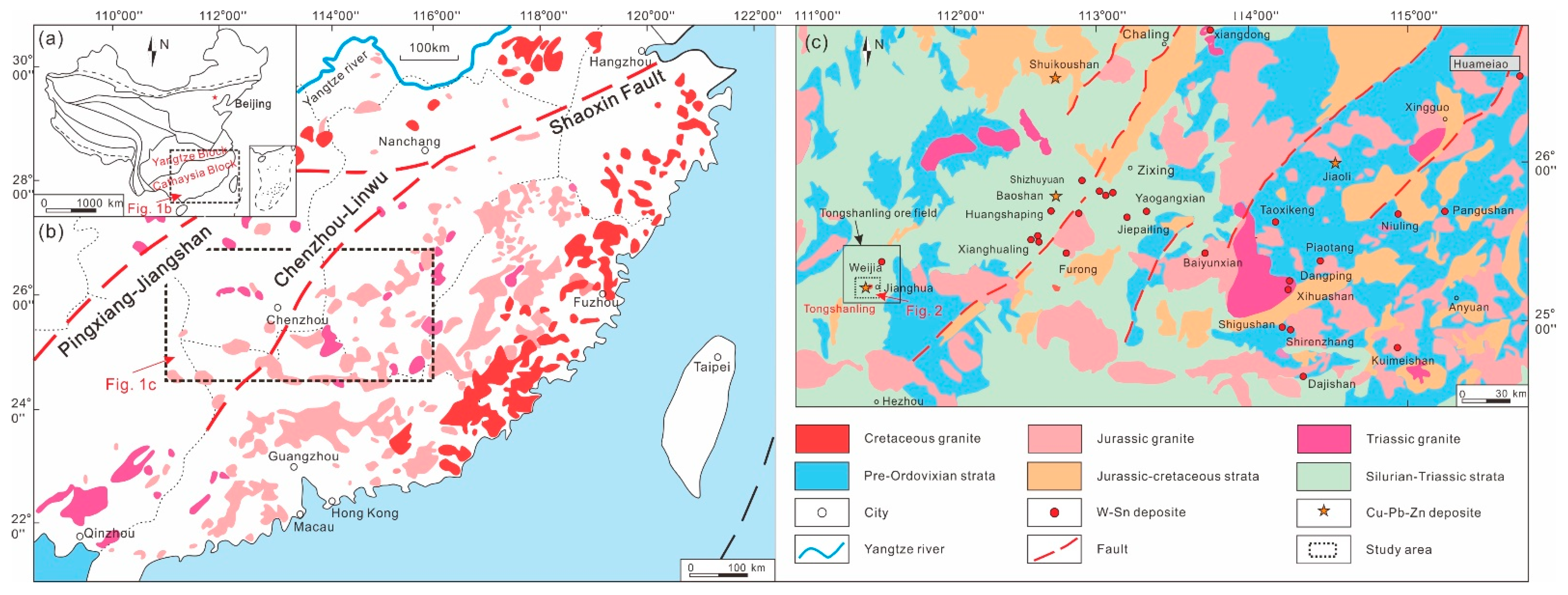
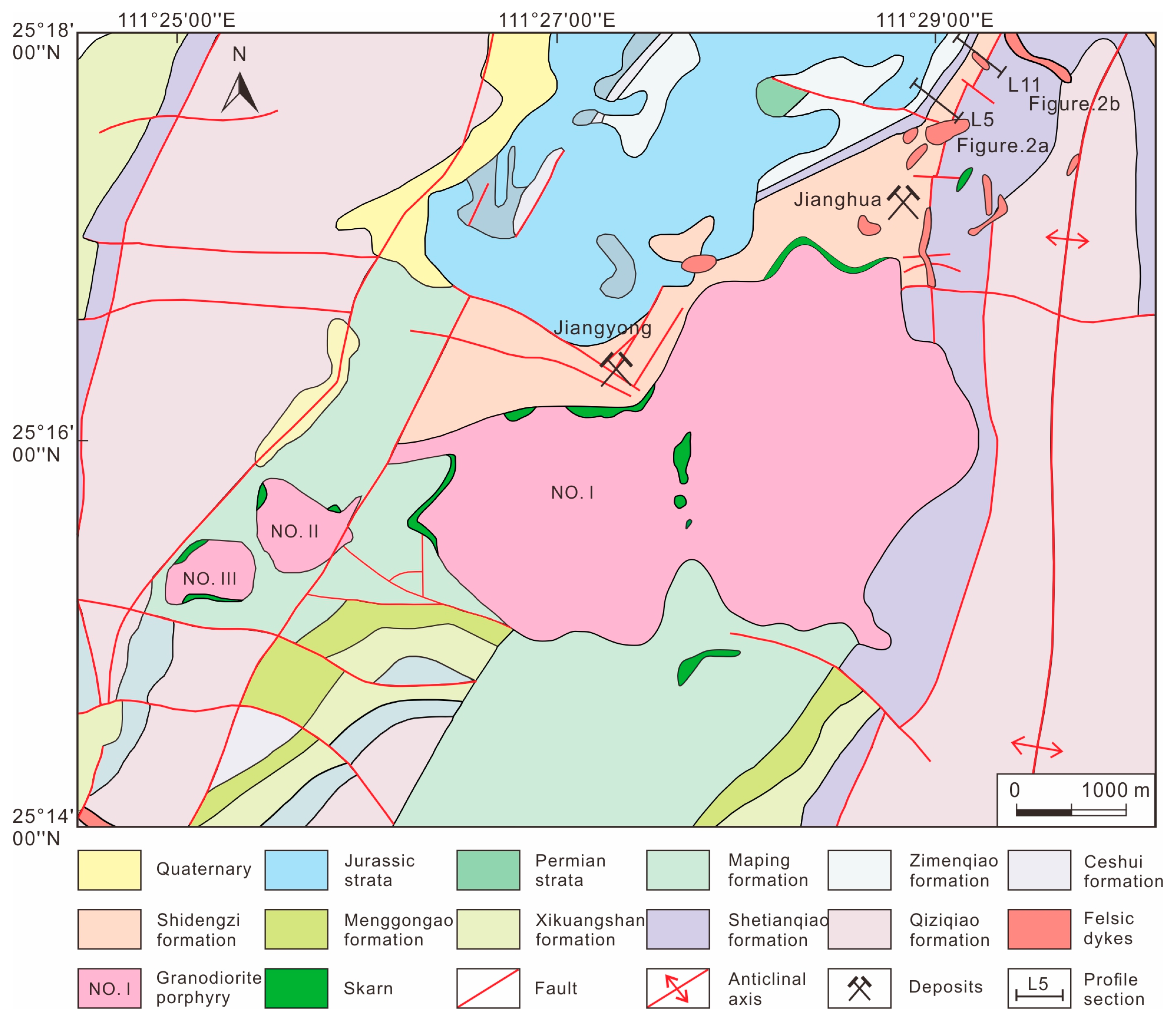

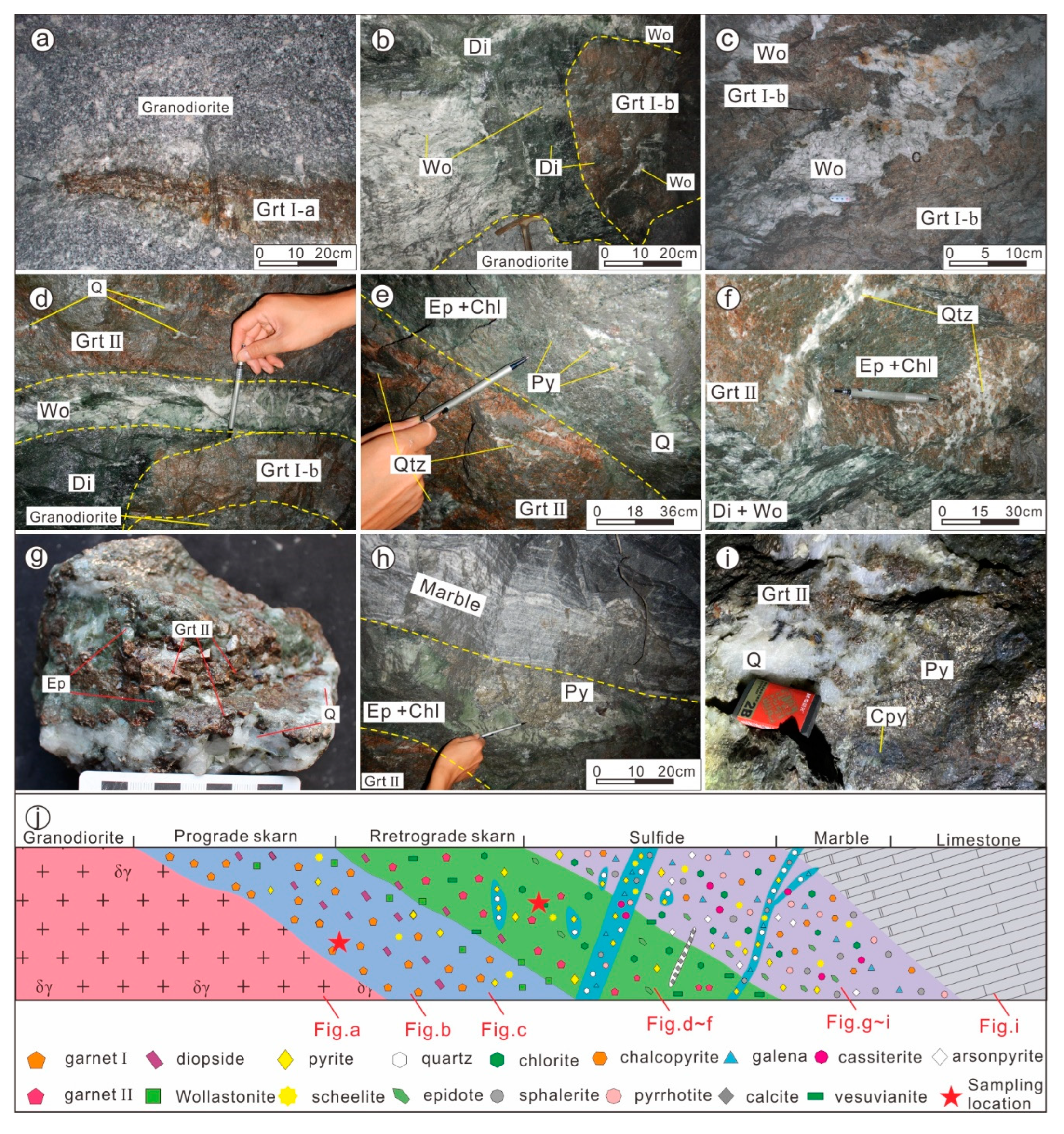

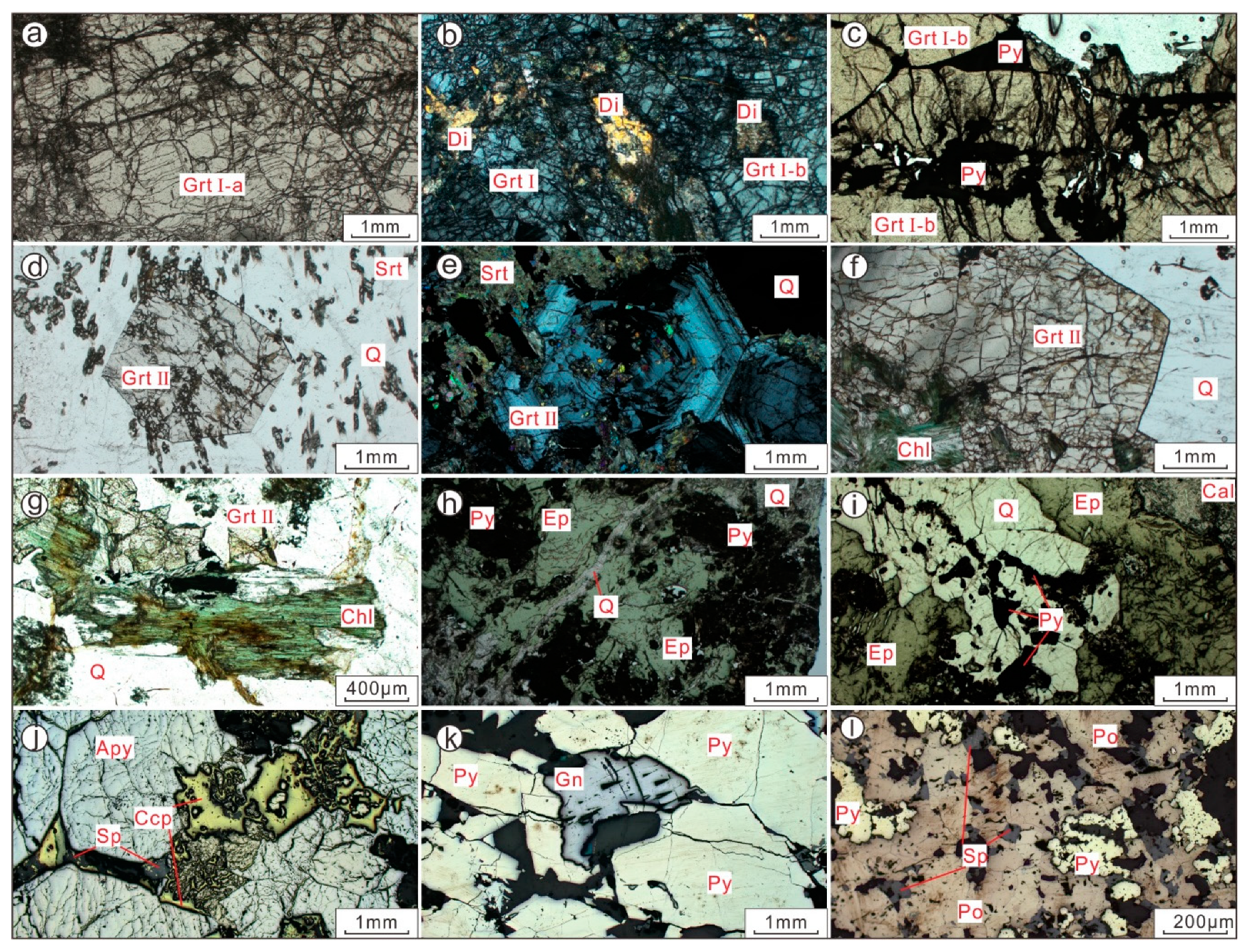

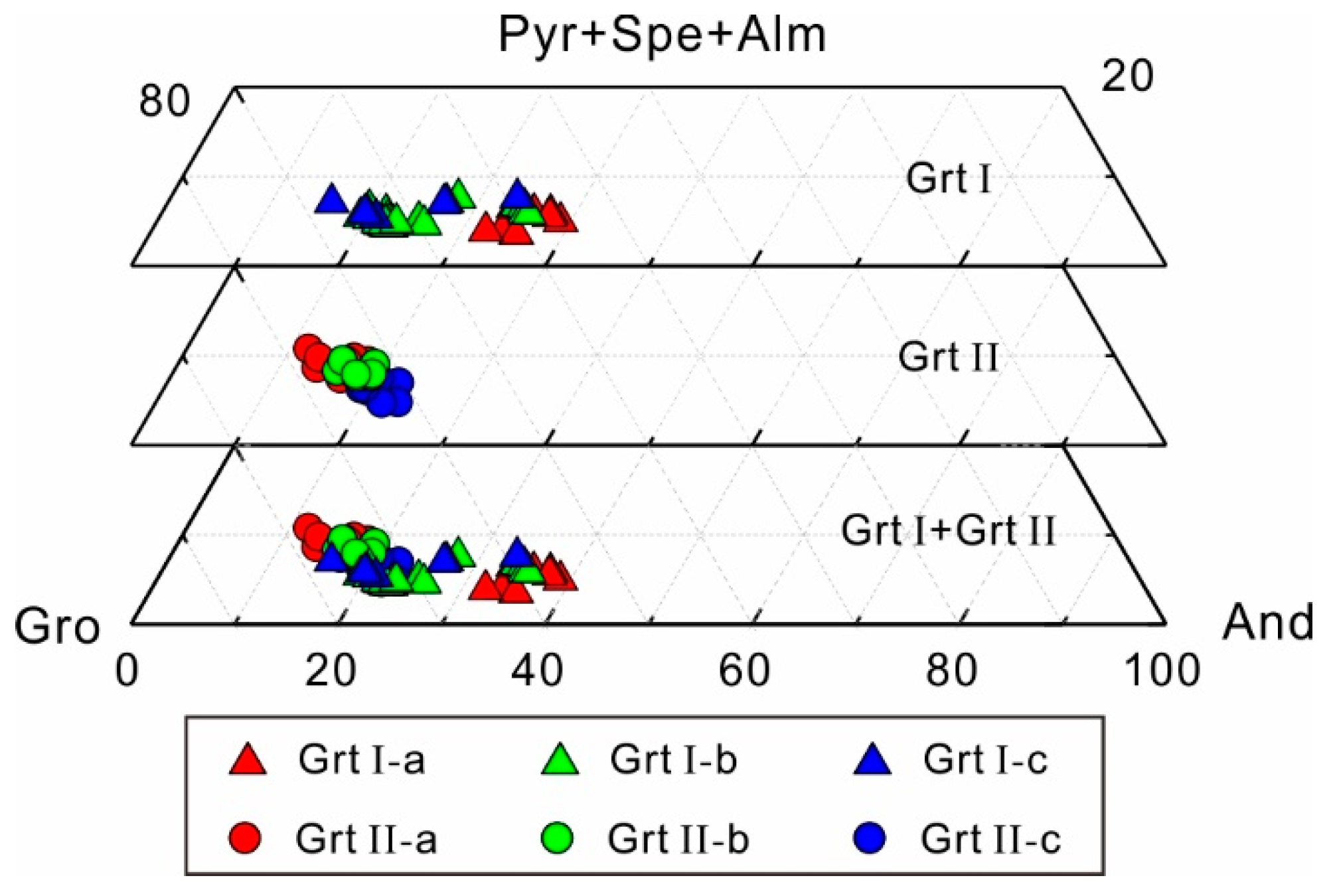
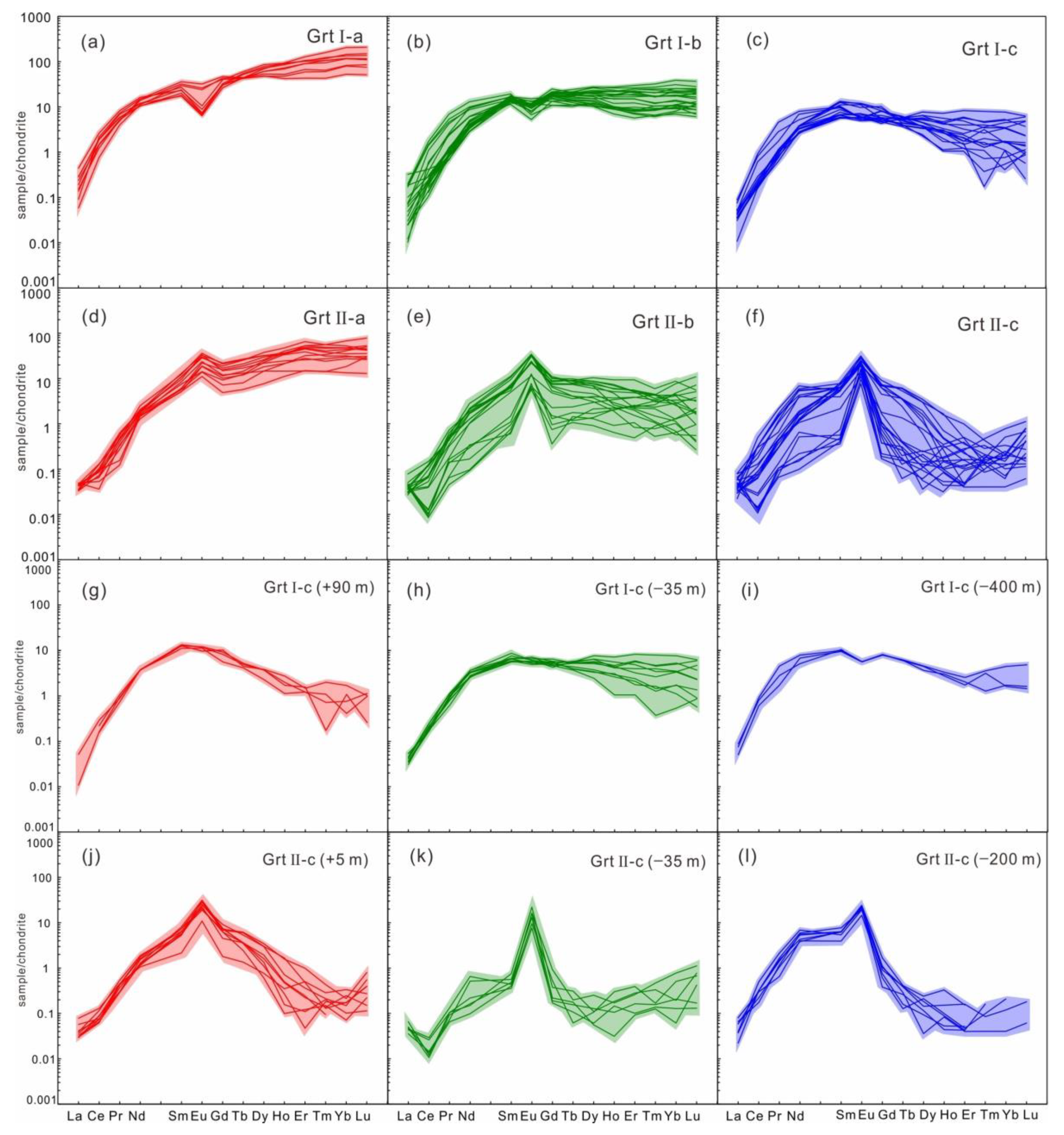
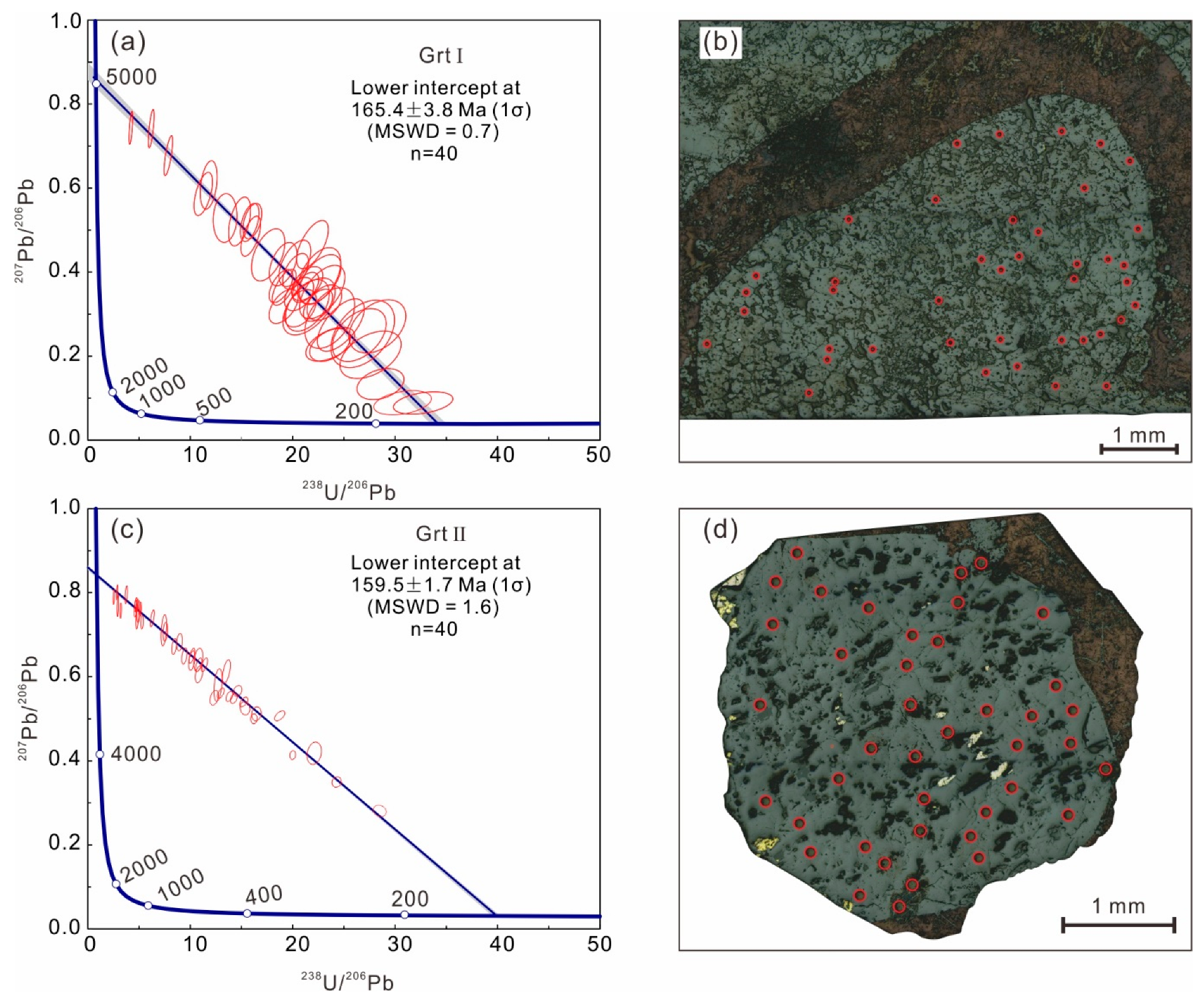
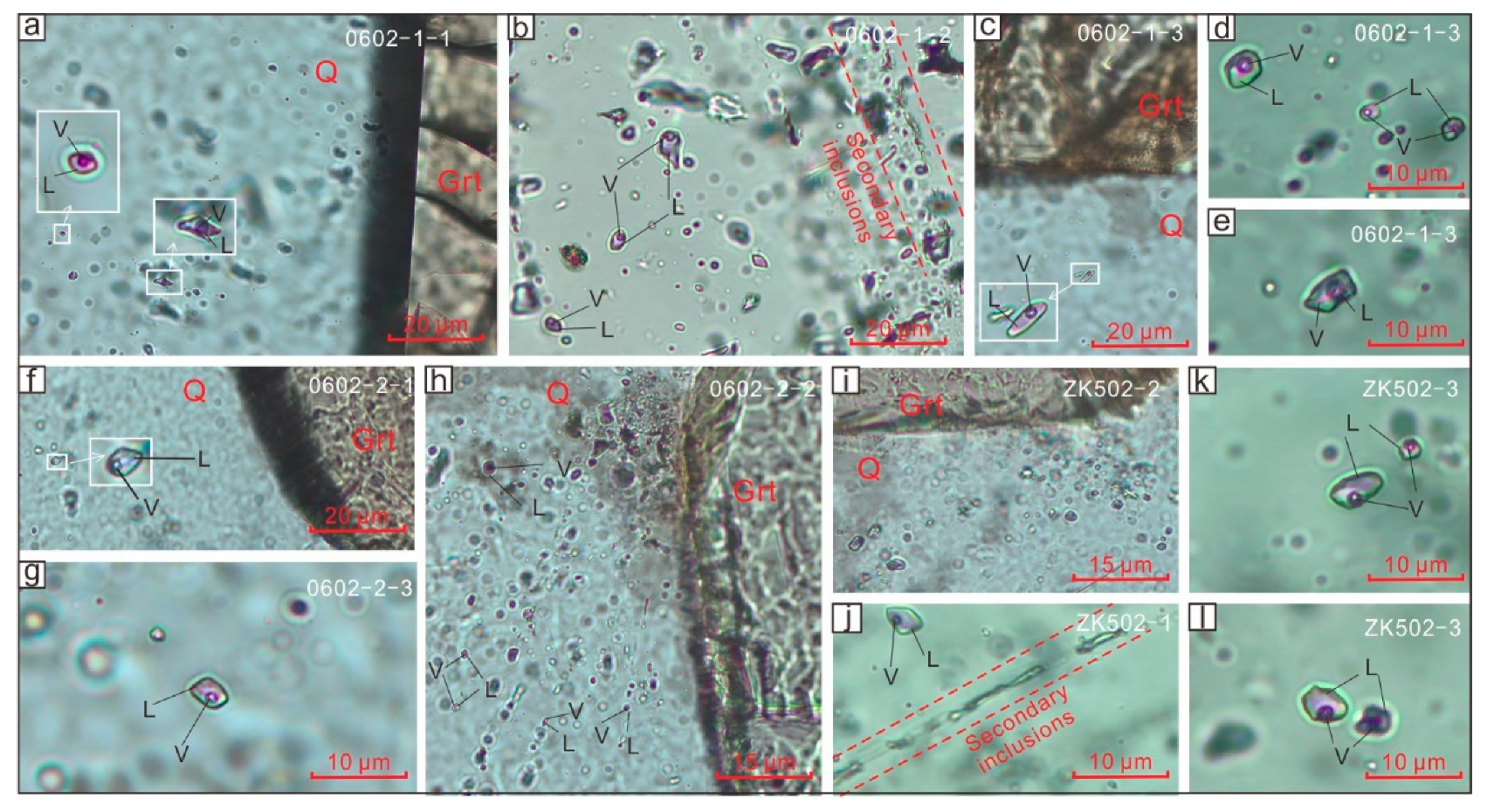
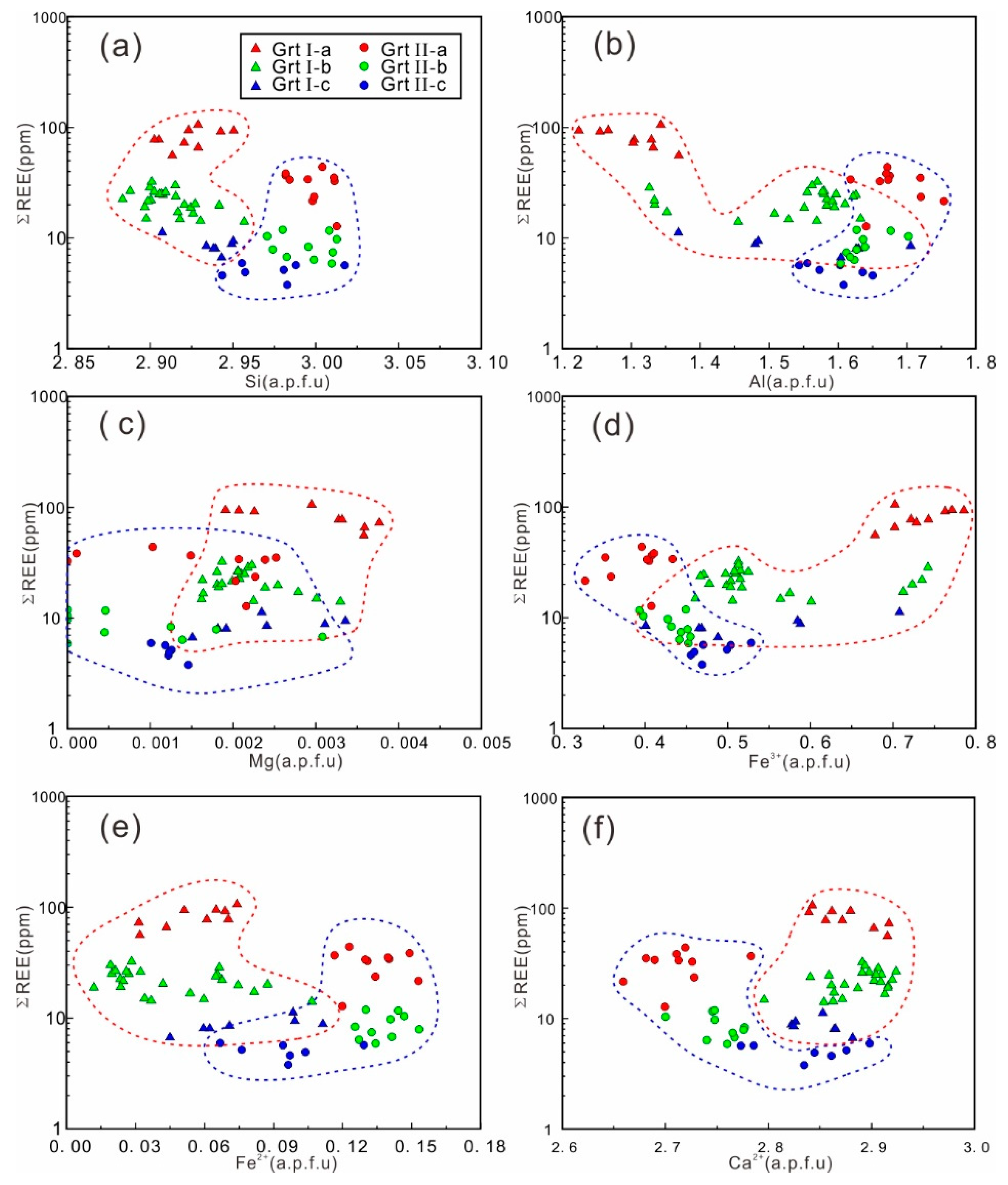
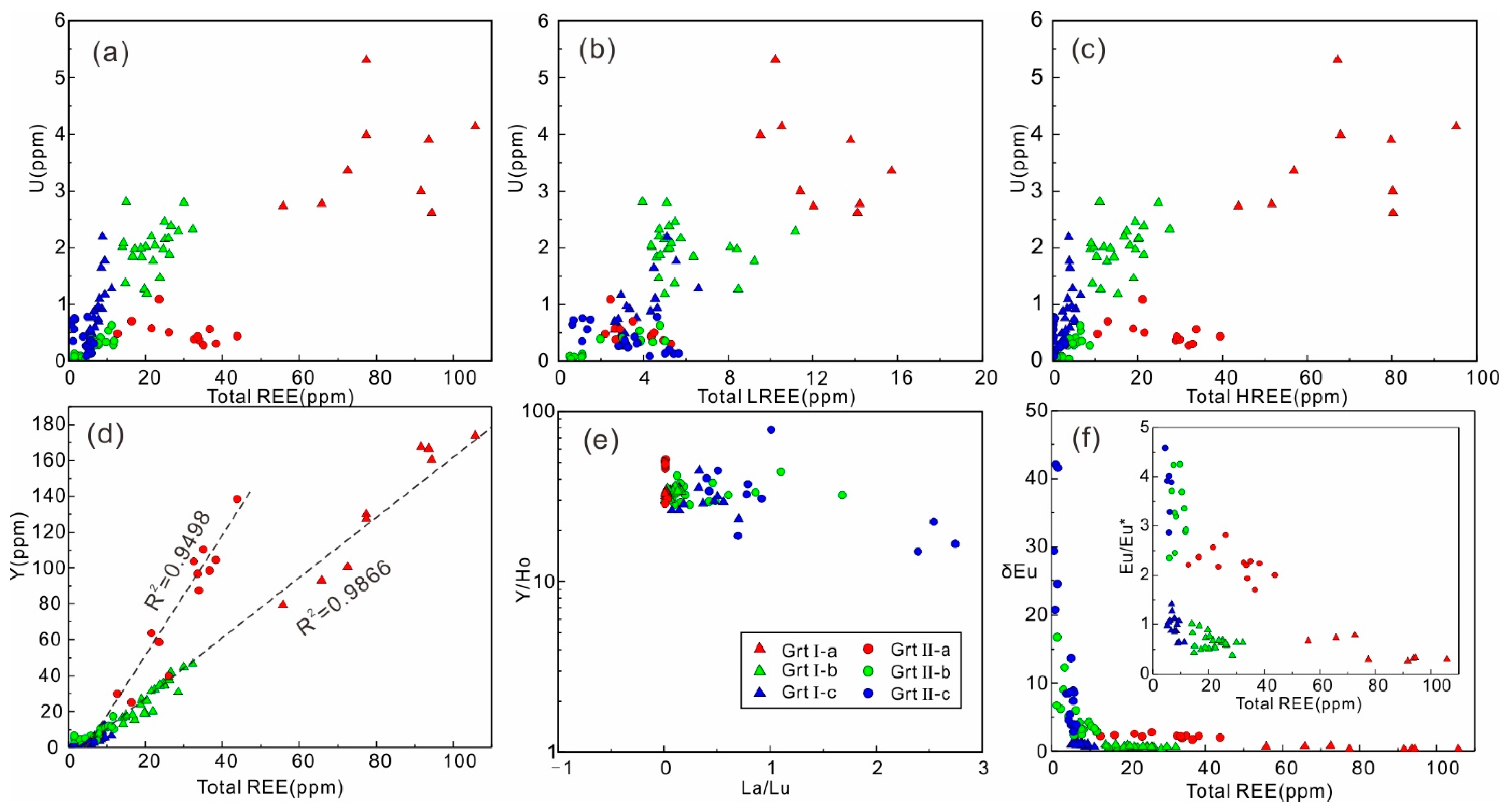
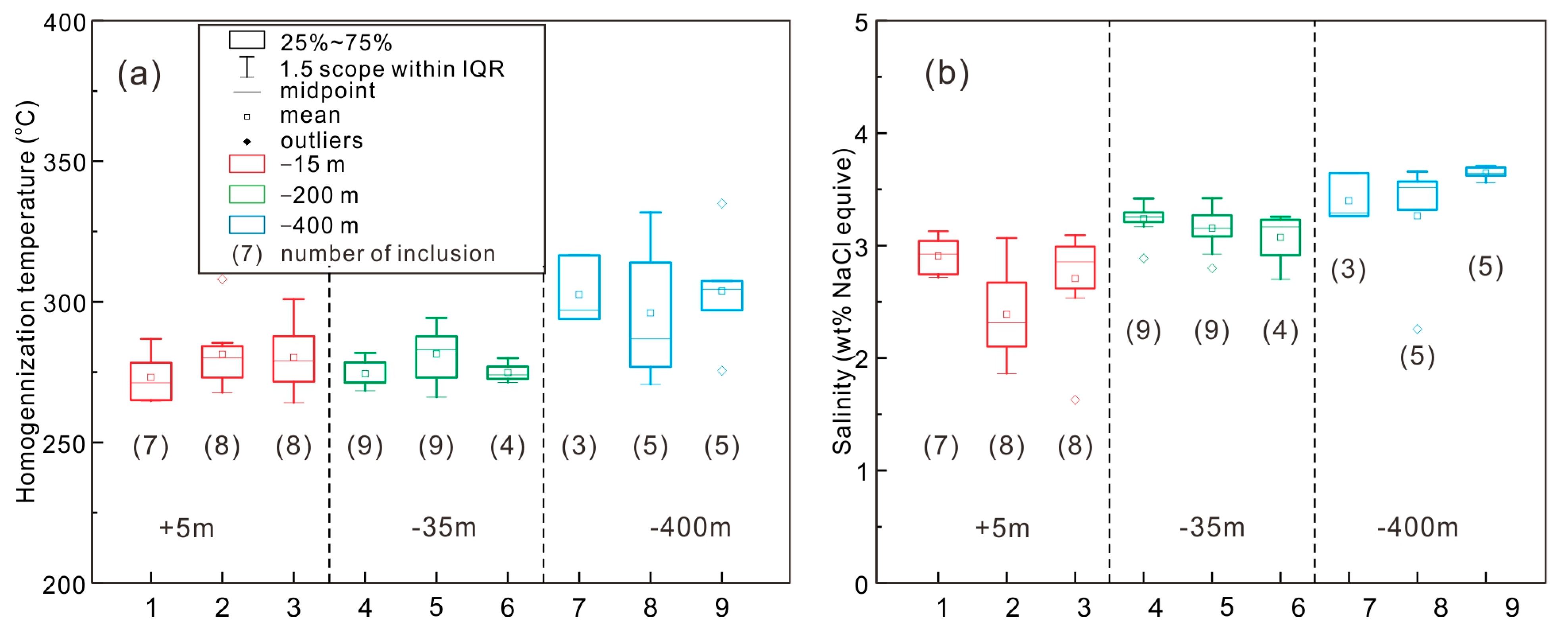
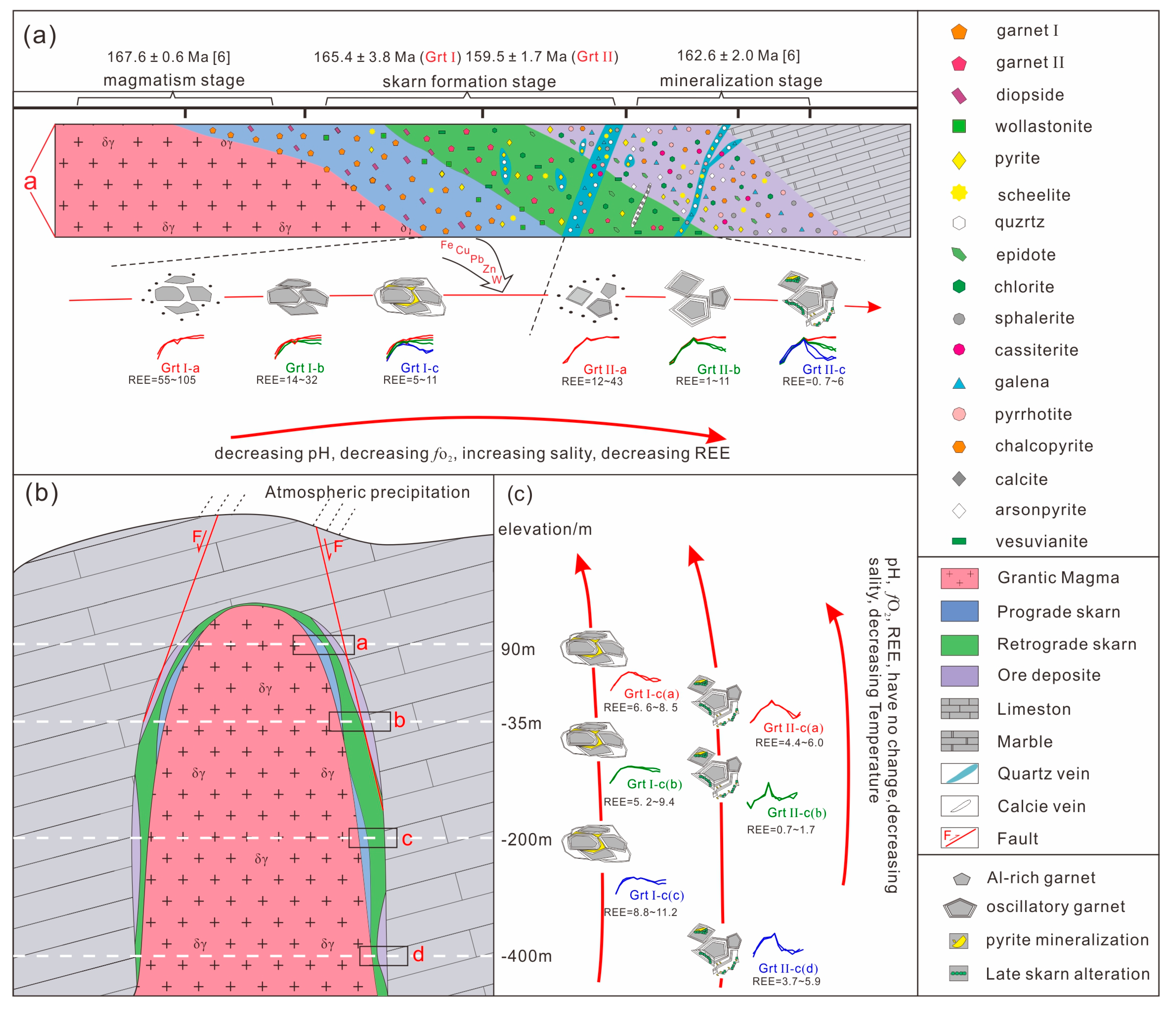
Disclaimer/Publisher’s Note: The statements, opinions and data contained in all publications are solely those of the individual author(s) and contributor(s) and not of MDPI and/or the editor(s). MDPI and/or the editor(s) disclaim responsibility for any injury to people or property resulting from any ideas, methods, instructions or products referred to in the content. |
© 2023 by the authors. Licensee MDPI, Basel, Switzerland. This article is an open access article distributed under the terms and conditions of the Creative Commons Attribution (CC BY) license (https://creativecommons.org/licenses/by/4.0/).
Share and Cite
Tan, F.; Kong, H.; Liu, B.; Wu, Q.; Chen, S. In Situ U—Pb Dating and Trace Element Analysis of Garnet in the Tongshanling Cu Polymetallic Deposit, South China. Minerals 2023, 13, 187. https://doi.org/10.3390/min13020187
Tan F, Kong H, Liu B, Wu Q, Chen S. In Situ U—Pb Dating and Trace Element Analysis of Garnet in the Tongshanling Cu Polymetallic Deposit, South China. Minerals. 2023; 13(2):187. https://doi.org/10.3390/min13020187
Chicago/Turabian StyleTan, Fucheng, Hua Kong, Biao Liu, Qianhong Wu, and Shefa Chen. 2023. "In Situ U—Pb Dating and Trace Element Analysis of Garnet in the Tongshanling Cu Polymetallic Deposit, South China" Minerals 13, no. 2: 187. https://doi.org/10.3390/min13020187
APA StyleTan, F., Kong, H., Liu, B., Wu, Q., & Chen, S. (2023). In Situ U—Pb Dating and Trace Element Analysis of Garnet in the Tongshanling Cu Polymetallic Deposit, South China. Minerals, 13(2), 187. https://doi.org/10.3390/min13020187





